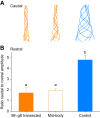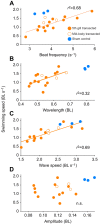Swimming kinematics and performance of spinal transected lampreys with different levels of axon regeneration
- PMID: 34632494
- PMCID: PMC8627570
- DOI: 10.1242/jeb.242639
Swimming kinematics and performance of spinal transected lampreys with different levels of axon regeneration
Abstract
Axon regeneration is critical for restoring neural function after spinal cord injury. This has prompted a series of studies on the neural and functional recovery of lampreys after spinal cord transection. Despite this, there are still many basic questions remaining about how much functional recovery depends on axon regeneration. Our goal was to examine how swimming performance is related to degree of axon regeneration in lampreys recovering from spinal cord transection by quantifying the relationship between swimming performance and percent axon regeneration of transected lampreys after 11 weeks of recovery. We found that while swimming speeds varied, they did not relate to percent axon regeneration. In fact, swimming speeds were highly variable within individuals, meaning that most individuals could swim at both moderate and slow speeds, regardless of percent axon regeneration. However, none of the transected individuals were able to swim as fast as the control lampreys. To swim fast, control lampreys generated high amplitude body waves with long wavelengths. Transected lampreys generated body waves with lower amplitude and shorter wavelengths than controls, and to compensate, transected lampreys increased their wave frequencies to swim faster. As a result, transected lampreys had significantly higher frequencies than control lampreys at comparable swimming velocities. These data suggest that the control lampreys swam more efficiently than transected lampreys. In conclusion, there appears to be a minimal recovery threshold in terms of percent axon regeneration required for lampreys to be capable of swimming; however, there also seems to be a limit to how much they can behaviorally recover.
Keywords: Petromyzon marinus; Anguilliform; Neuromuscular.
© 2021. Published by The Company of Biologists Ltd.
Conflict of interest statement
Competing interests The authors declare no competing or financial interests.
Figures






References
-
- Blight, A. R. (1977). The muscular control of vertebrate swimming movements. Biol. Rev. 52, 181-218. 10.1111/j.1469-185X.1977.tb01349.x - DOI
Publication types
MeSH terms
LinkOut - more resources
Full Text Sources
Research Materials

